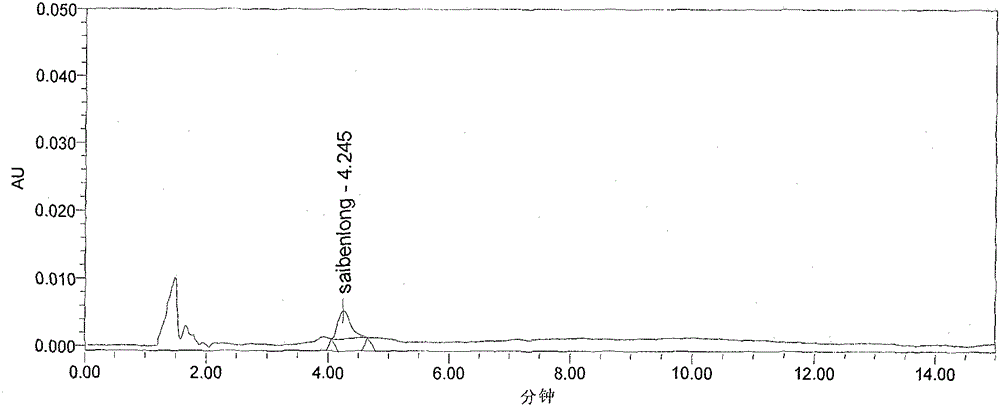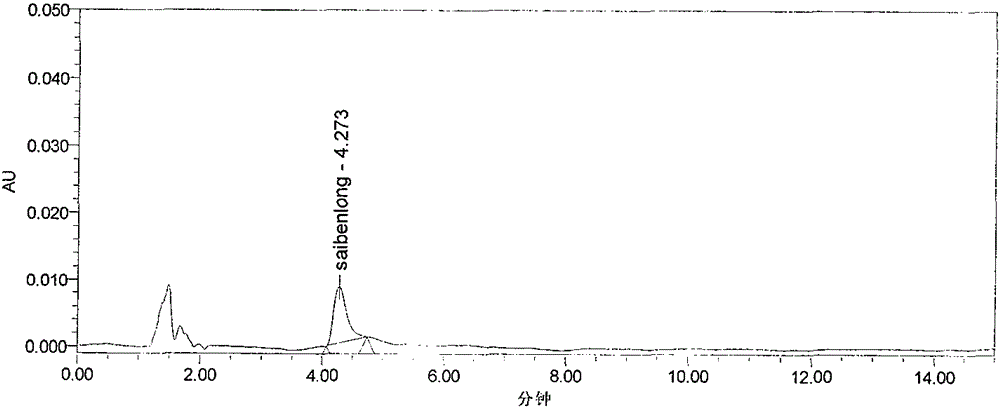Method for detecting regulating-agent thidiazuron residues and regulating-agent diuron residues
A technology for thidiazuron and diuron is applied in the field of detecting the residues of regulators thidiazuron and diuron, which can solve problems such as residues, and achieve the effects of satisfying the detection limit, simple purification, and satisfactory precision.
- Summary
- Abstract
- Description
- Claims
- Application Information
AI Technical Summary
Problems solved by technology
Method used
Image
Examples
Embodiment 1
[0055] Weigh 20.0g of the prepared cotton leaf sample (accurate to 0.01g) into a 200mL glass bottle, add 10mL of water and 50mL of acetonitrile, mix thoroughly, ultrasonically extract for 20min, and filter with filter paper until 3g of sodium chloride is added. In a stoppered measuring cylinder, shake vigorously for 1 min, and after standing for 1 h, accurately pipette 25 mL of supernatant into a 100 mL beaker, place on a heating plate, and blow with nitrogen at 50 °C to nearly dry.
Embodiment 2
[0057] Weigh about 5.0 g of soil samples and dry them at 105°C to constant weight to measure the water content in the soil. Then accurately weigh 20.0 g of the prepared soil sample (accurate to 0.01 g) into a 100 mL centrifuge tube, add 10 mL of water and 50 mL of acetonitrile, vortex for 1 min, sonicate for 20 min, and centrifuge at 4000 r / min for 5 min. The supernatant was filtered through filter paper into a stoppered measuring cylinder added with 3g of sodium chloride, shaken vigorously for 1min, and after standing for 1h, accurately pipette 25mL of the supernatant into a 100mL beaker, placed on a heating plate, and blown with nitrogen at 50°C near Dry.
Embodiment 3
[0059] Accurately weigh 10.0g (accurate to 0.01g) of the prepared cottonseed sample into a 100mL centrifuge tube, add 10mL water and 50mL acetonitrile, vortex for 1min, sonicate for 20min, and centrifuge at 4000r / min for 5min. The supernatant was filtered through filter paper into a stoppered measuring cylinder added with 3g of sodium chloride, shaken vigorously for 1min, and after standing for 1h, accurately pipette 25mL of the supernatant into a 100mL beaker, placed on a heating plate, and blown with nitrogen at 50°C near Dry.
[0060] C 18 The column was pre-rinsed with 5mL ethyl acetate, 5mL ethyl acetate dissolved the sample residue, and transferred to the column, then eluted with 10mL ethyl acetate, the eluate was collected, and placed on an electric heating plate at 35°C and blown with nitrogen to dry it. . Accurately dilute to 2mL with methanol, and filter through a 0.22μm needle-hole filter into a 2mL injection vial for testing.
PUM
| Property | Measurement | Unit |
|---|---|---|
| wavelength | aaaaa | aaaaa |
| recovery rate | aaaaa | aaaaa |
Abstract
Description
Claims
Application Information
 Login to View More
Login to View More - R&D
- Intellectual Property
- Life Sciences
- Materials
- Tech Scout
- Unparalleled Data Quality
- Higher Quality Content
- 60% Fewer Hallucinations
Browse by: Latest US Patents, China's latest patents, Technical Efficacy Thesaurus, Application Domain, Technology Topic, Popular Technical Reports.
© 2025 PatSnap. All rights reserved.Legal|Privacy policy|Modern Slavery Act Transparency Statement|Sitemap|About US| Contact US: help@patsnap.com



